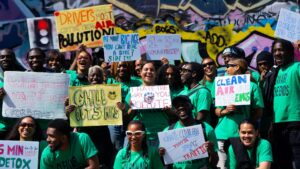Experts have discovered simple ways to drastically cut air pollution surrounding schools in London, protecting children from adverse health effects.
Research published by architectural firm Arup, Global Action Plan, and University of Surrey, with support from Impact on Urban Health, showed how simple action can reduce outdoor and indoor exposure to toxins by almost half.
Working with several schools in Lambeth, Surrey’s Global Centre for Clean Air Research (GCARE) investigated whether putting up a green screen along each school’s perimeter fence, installing air purifiers in classrooms and organising School Street initiatives would improve air quality.
Findings showed that air purifiers could reduce indoor pollution concentrations by 57%, while green screens places at school boundaries reduced outdoor particle levels coming from roads by up to 44%, depending on wind conditions.
School Streets initiatives, which prevent cars from driving past schools during pick-up and drop-off hours, could also reduce particle concentrations by 36%.
Prashant Kumar, founding Director of GCARE at the University of Surrey, said: ‘Everybody, especially our children, deserves to live and work where the air is as clean and safe as possible. Unfortunately, the reality is far from ideal, with many of our schools unwittingly exposing children to harmful pollutants. The problem is particularly bad at schools near busy roads.
‘Our research offers hope to many who care about this issue, as the results show that taking reasonable action can make a positive difference.’
Currently, all London schools breach the World Health Organisation’s air quality limits, leaving children at risk of developing respiratory diseases, poor lung and brain health, behavioural problems, and cancer.
The Mayor of London’s has put the London Schools Pollution Helpdesk in place to support schools to find ways of tackling air quality with free educational resources, action plans and campaign guidance.
Shirley Rodrigues, London Deputy Mayor for Environment and Energy, said: ‘The Mayor is doing everything in his power to stop Londoners breathing toxic air. Since 2016, there has been a 96% reduction in the number of schools in areas which exceed the legal pollution limit for nitrogen dioxide, and he is committed to bringing that number down to zero.’
School Street schemes are becoming more popular across the country, as Newcastle has recently announced plans for it’s second school street in Gosforth, while two more schools have signed up to the initiative in Portsmouth.
Photo by note thanun
















Leave a Reply